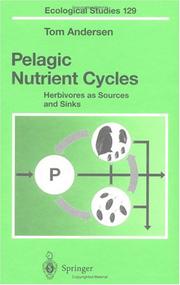| Listing 1 - 1 of 1 |
Sort by
|

ISBN: 3540618813 3642082793 3662034182 9783540618812 Year: 1997 Volume: 129 Publisher: Berlin : Springer,
Abstract | Keywords | Export | Availability | Bookmark
 Loading...
Loading...Choose an application
- Reference Manager
- EndNote
- RefWorks (Direct export to RefWorks)
While ecology is one of the scientific disiplines that most clearly belongs to ''basic research", it also strives to serve as a predictive tool for management. Outstanding examples of predictive ecology are Vollenweider's models on the relationship between phosphorus load and water renewal time of lakes, and the resulting algal biomass. The needed few and easily accessible input parameters to very simple models provided a direct link from basic ecology to management, and today these models are key tools for managers worldwide to control lake eutrophication and algal blooms. The baseline of this success is the general relation between phosphorus concentration and phytoplankton biomass that is observed for most lakes. While these relationships are most frequently presented in log-log diagrams, the aquatic ecologist who replots these a linear scale may ask himself why, in spite of the overall correlation, there is still such a variability. It is possible to predict levels of algal biomass that may be synthesized at a given phosphorus load. Some lakes apparently offer optimal conditions for their phytoplankton communities, while others may support less than half the biomass at the same phosphorus load. There are limits to growth, however, and the predic tive outcome of phosphorus load decreases as the load increases. This holds in particular for the higher trophic levels like zooplankton and fish. With increased enrichment there are signs of decreased efficiency of energy trans fer between foodweb compartments.
Herbivores --- Nutrient cycles --- Food chains (Ecology) --- Food --- Issue --- Ecology . --- Life sciences. --- Agriculture. --- Geoecology. --- Environmental geology. --- Nature conservation. --- Oceanography. --- Ecology. --- Life Sciences, general. --- Geoecology/Natural Processes. --- Nature Conservation. --- Oceanography, Physical --- Oceanology --- Physical oceanography --- Thalassography --- Earth sciences --- Marine sciences --- Ocean --- Conservation of nature --- Nature --- Nature protection --- Protection of nature --- Conservation of natural resources --- Applied ecology --- Conservation biology --- Endangered ecosystems --- Natural areas --- Geoecology --- Environmental protection --- Physical geology --- Farming --- Husbandry --- Industrial arts --- Life sciences --- Food supply --- Land use, Rural --- Biosciences --- Sciences, Life --- Science --- Balance of nature --- Biology --- Bionomics --- Ecological processes --- Ecological science --- Ecological sciences --- Environment --- Environmental biology --- Oecology --- Environmental sciences --- Population biology --- Conservation --- Ecology --- Nutrient cycles. --- Food webs (Ecology) --- Trophic ecology --- Animals --- Nutrient cycling --- Biogeochemical cycles --- Herbivores - Food --- CYCLING --- LAKES --- NUTRIENTS --- ALGAE --- HERBIVORES --- FOOD CHAINS --- EUTROPHICATION --- BIOGEOCHEMICAL CYCLES --- DYNAMIC MODELS
| Listing 1 - 1 of 1 |
Sort by
|

 Search
Search Feedback
Feedback About
About Help
Help News
News